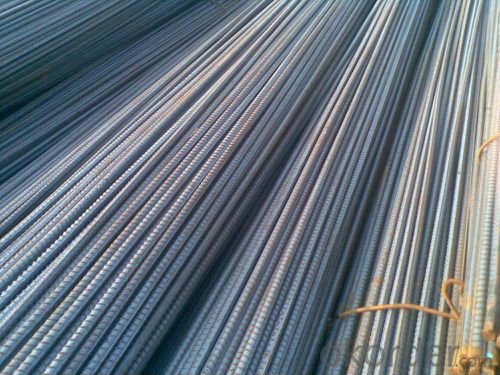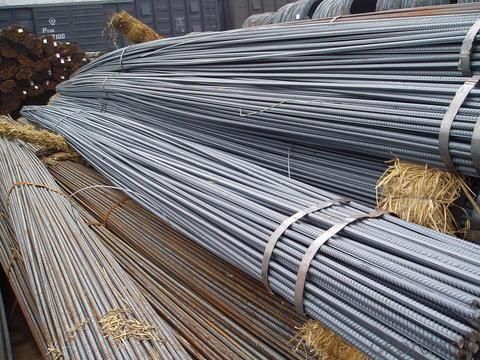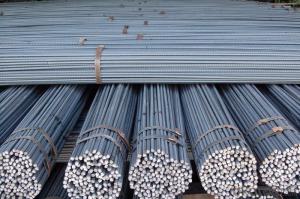High Quality Steel Deformed Bar HRB400 18/20/22mm
- Loading Port:
- Tianjin
- Payment Terms:
- TT or LC
- Min Order Qty:
- 100 m.t
- Supply Capability:
- 10000 m.t/month
OKorder Service Pledge
OKorder Financial Service
You Might Also Like
High Quality Steel Deformed Bar HRB400 18/20/22mm
Product Description:
Specifications of High Quality Steel Deformed Bar HRB400 18/20/22mm:
Standard | GB | HRB400 | |
Diameter | 18mm,20mm, 22mm | ||
Length | 6M, 12M | ||
Place of origin | Hebei, China mainland | ||
Advantages | exact size, regular package, chemical and mechanical properties are stable. | ||
Type | Hot rolled deformed steel bar | ||
Chemical Composition of High Quality Steel Deformed Bar HRB400 18/20/22mm: (Please kindly find our chemistry of our material based on HRB400 as below for your information)
Grade | Technical data of the original chemical composition (%) | ||||||
C | Mn | Si | S | P | V | ||
HRB400 | ≤0.25 | ≤1.60 | ≤0.80 | ≤0.045 | ≤0.045 | 0.04-0.12 | |
Physical capability | |||||||
Yield Strength (N/cm²) | Tensile Strength (N/cm²) | Elongation (%) | |||||
≥400 | ≥570 | ≥14 | |||||
Theoretical weight and section area of High Quality Steel Deformed Bar HRB400 18/20/22mm as below for your information:
Diameter(mm) | Section area (mm²) | Mass(kg/m) | Weight of 12m bar(kg) |
18 | 254.5 | 2.00 | 24 |
20 | 314.2 | 2.47 | 29.64 |
22 | 380.1 | 2.98 | 35.76 |
Usage and Applications of High Quality Steel Deformed Bar HRB400 18/20/22mm:
Deformed bar is widely used in buildings, bridges, roads and other engineering construction. Big to highways, railways, bridges, culverts, tunnels, public facilities such as flood control, dam, small to housing construction, beam, column, wall and the foundation of the plate, deformed bar is an integral structure material. With the development of world economy and the vigorous development of infrastructure construction, real estate, the demand for deformed bar will be larger and larger.
Packaging & Delivery of High Quality Steel Deformed Bar HRB400 18/20/22mm:
Packaging Detail: products are packed in bundle and then shipped by container or bulk vessel, deformed bar is usually naked strapping delivery, when storing, please pay attention to moisture proof. The performance of rust will produce adverse effect.
Each bundle weight: 2-3MT, or as required
Payment term: TT or L/C
Delivery Detail: within 45 days after received advanced payment or LC.
Label: to be specified by customer, generally, each bundle has 1-2 labels
Trade terms: FOB, CFR, CIF
FAQ:
Q1: Why buy Materials & Equipment from OKorder.com?
A1: All products offered byOKorder.com are carefully selected from China's most reliable manufacturing enterprises. Through its ISO certifications, OKorder.com adheres to the highest standards and a commitment to supply chain safety and customer satisfaction.
Q2: How do we guarantee the quality of our products?
A2: We have established an advanced quality management system which conducts strict quality tests at every step, from raw materials to the final product. At the same time, we provide extensive follow-up service assurances as required.
Q3: How soon can we receive the product after purchase?
A3: Within three days of placing an order, we will arrange production. The shipping date is dependent upon the quatity, how many sizes you want and the plan of production, but is typically 1 month to 2 month days from the beginning of production.
Images of High Quality Steel Deformed Bar HRB400 18/20/22mm:


*If you would like to get our price, please inform us the size, standard/material and quantity. Thank you very much for your attention.
- Q:Can steel rebars be used in wastewater storage tanks?
- Yes, steel rebars can be used in wastewater storage tanks.
- Q:What are the weight and density of steel rebars?
- Steel rebars, also known as reinforcing bars, are commonly used in construction to provide tensile strength to concrete structures. The weight and density of steel rebars can vary depending on their size and grade. The weight of a steel rebar is determined by its cross-sectional area and the specific weight of steel, which is approximately 7850 kilograms per cubic meter (or 0.2836 pounds per cubic inch). The cross-sectional area is typically measured in square millimeters or square inches. For example, a common size of steel rebar is the #4 bar, which has a diameter of 12.7 millimeters (or 0.5 inches) and a cross-sectional area of 127 square millimeters (or 0.197 square inches). Using the specific weight of steel, we can calculate the weight of a #4 rebar as follows: Weight = Cross-sectional area x Specific weight of steel Weight = 127 mm^2 x 7850 kg/m^3 Weight = 998,950 grams or approximately 998.95 kilograms (or 2,201 pounds) In terms of density, the density of steel rebars is the same as the specific weight of steel, which is approximately 7850 kilograms per cubic meter. This density is relatively consistent across different sizes and grades of steel rebars. It is important to note that the weight and density of steel rebars can vary slightly depending on the specific composition and manufacturing process. Therefore, it is always recommended to refer to the manufacturer's specifications or consult engineering references for accurate and up-to-date information.
- Q:Can steel rebars be used in structures with high levels of carbonation or acid attack?
- No, steel rebars should not be used in structures with high levels of carbonation or acid attack. Steel is susceptible to corrosion in acidic environments, and high carbonation levels can increase the acidity of the surroundings. In such conditions, alternative materials that are resistant to corrosion and acid attack, such as stainless steel or fiber-reinforced polymers, should be considered for structural reinforcement.
- Q:What are the typical costs associated with using steel rebars in a construction project?
- The typical costs associated with using steel rebars in a construction project can vary depending on several factors. These factors include the size and type of the rebar, the quantity needed, the market conditions, and the location of the project. The cost of steel rebars is usually determined per ton or per linear foot. The price per ton can range from $400 to $600, while the price per linear foot can be anywhere between $0.75 to $1.50. It is important to note that these prices are approximate and can fluctuate based on market demand and availability. Additionally, there may be additional costs involved in the procurement and handling of steel rebars. This can include transportation fees, storage costs, and any necessary equipment or tools required for installation. Other cost considerations may include labor expenses for cutting, bending, and placing the rebars, as well as any reinforcement detailing required by the project's design specifications. These costs can vary depending on the complexity of the project and the skill level of the laborers involved. It is also essential to factor in any potential wastage or scrap material that may occur during the construction process. Proper planning and accurate measurements can help minimize these costs. Overall, the typical costs associated with using steel rebars in a construction project can be significant, but they are necessary for ensuring structural integrity and reinforcement. It is advisable to obtain quotes from multiple suppliers and contractors to ensure competitive pricing and to carefully consider the specific requirements of the project before finalizing the budget.
- Q:Are there any specific safety precautions to be taken while handling steel rebars?
- Yes, there are several safety precautions that should be taken while handling steel rebars. Here are some key points to consider: 1. Personal Protective Equipment (PPE): Always wear appropriate PPE, including safety goggles or glasses, gloves, and steel-toed boots. This will help protect against eye injuries, cuts, and crushed toes. 2. Lifting Techniques: When lifting rebars, use proper lifting techniques such as bending at the knees, keeping the back straight, and using leg muscles to lift the load. Avoid twisting or jerking motions while lifting to prevent strains or sprains. 3. Proper Storage: Store rebars in an organized and secure manner, ensuring they are not leaning against walls or other structures. This will prevent them from falling and causing injuries. 4. Sharp Edges: Be cautious of the sharp edges on rebars. Always handle them with care to avoid cuts or punctures. It is recommended to wear protective gloves to reduce the risk of hand injuries. 5. Secure Transportation: When transporting rebars, secure them properly to prevent movement or falling off the vehicle. Use appropriate restraints such as ropes or straps to secure the load safely. 6. Electrical Hazards: Be aware of any overhead power lines or live electrical sources near the working area. Maintain a safe distance from them to prevent accidental contact with the rebars, which can conduct electricity. 7. Communication and Awareness: Always communicate with other workers in the vicinity to ensure everyone is aware of the presence of rebars. This will help prevent accidental injuries caused by tripping or colliding with the rebars. By following these safety precautions, you can minimize the risk of accidents or injuries while handling steel rebars. It is also important to undergo proper training and adhere to any specific safety guidelines provided by your employer or industry regulations.
- Q:Can steel rebars corrode or rust over time?
- Yes, steel rebars can corrode or rust over time due to exposure to moisture and oxygen.
- Q:What is the manufacturing process of the hot rolled thread steel production line?
- Reheating furnace, roughing mill, rolling mill, rolling mill, water cooling device, cooling bed, cold shear, automatic counting device, bundling machine, unloading bench is calculated from the Shanghai kuanli Steel Co. Ltd. to provide thread steel weight: diameter * * outer diameter theory 0.00617=kg/m theory and 6.50.260 steel manufacturers specifications Jiuzheng 8.00.395 Jiuzheng steel 100.617 steel 120.888 steel 141.21 nine nine nine nine nine steel 161.58 steel 182 steel 202.47 steel 222.98 steel 253.85 nine nine nine nine nine steel 284.83 steel 326.31 steel.
- Q:How do steel rebars perform in structures exposed to harsh chemicals?
- Steel rebars perform well in structures exposed to harsh chemicals due to their inherent corrosion resistance. The protective oxide layer formed on the steel surface prevents chemical reactions, ensuring the rebars maintain their strength and integrity over time. However, in extremely aggressive environments, additional protective coatings or higher grades of stainless steel rebars may be required to enhance their performance and longevity.
- Q:What are the advantages of using epoxy-coated stainless steel rebars?
- Epoxy-coated stainless steel rebars offer several advantages compared to traditional steel rebars. Firstly, the epoxy coating provides excellent corrosion resistance, protecting the rebar from moisture and chemicals present in the surrounding environment. This ensures the longevity and durability of the structure, reducing maintenance and repair costs over time. Additionally, stainless steel rebars possess high strength and are resistant to fire, making them suitable for use in harsh and high-temperature conditions. The epoxy coating also enhances the bond between the rebar and the concrete, improving the overall structural integrity. Lastly, the use of stainless steel rebars reduces the risk of staining or rust bleeding, resulting in a more aesthetically pleasing end product.
- Q:Can steel rebars be used in architectural or decorative concrete applications?
- Yes, steel rebars can be used in architectural or decorative concrete applications. They provide structural reinforcement and enhance the overall strength and durability of the concrete. Additionally, when properly designed and installed, steel rebars can be concealed or incorporated into the design, making them suitable for various aesthetic purposes in architectural or decorative concrete projects.
1. Manufacturer Overview |
|
|---|---|
| Location | |
| Year Established | |
| Annual Output Value | |
| Main Markets | |
| Company Certifications | |
2. Manufacturer Certificates |
|
|---|---|
| a) Certification Name | |
| Range | |
| Reference | |
| Validity Period | |
3. Manufacturer Capability |
|
|---|---|
| a)Trade Capacity | |
| Nearest Port | |
| Export Percentage | |
| No.of Employees in Trade Department | |
| Language Spoken: | |
| b)Factory Information | |
| Factory Size: | |
| No. of Production Lines | |
| Contract Manufacturing | |
| Product Price Range | |
Send your message to us
High Quality Steel Deformed Bar HRB400 18/20/22mm
- Loading Port:
- Tianjin
- Payment Terms:
- TT or LC
- Min Order Qty:
- 100 m.t
- Supply Capability:
- 10000 m.t/month
OKorder Service Pledge
OKorder Financial Service
Similar products
New products
Hot products
Related keywords





























